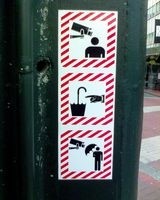Safety Signs For The Occupational Environment

Safety signs in the workplace are posted to prevent deaths, illnesses or injuries to employees, customers and visitors. A safety sign can detail health and safety hazards, warnings or instructions. Employers must posts safety signs in the workplace to help maintain a safe occupational environment, and those who do not are violating Occupational Health and Safety Administration (OSHA) regulations and may be cited or face legal lawsuits.
History
The Occupational Health and Safety Act was passed by Congress in 1971 to help prevent injuries, death and accidents in the workplace. To this end, OSHA requires the posting of accident prevention signs and tags. The posting of safety signs does not eliminate accidents, injuries and deaths, but injuries have declined 42 percent and deaths have decreased by 62 percent since the act was passed.
Types
The different types of safety signs that should be posted in the occupational environment include danger signs, stop signs, caution signs and hazardous equipment sign. The signs make employees, customers or visitors aware of health and safety hazards that can arise. For instance, a sign located by a steep step might read "Beware of Sudden Drop," letting people know to watch their step.
Considerations
An employer or business is responsible for posting signage to notify employees and visitors about any safety and health hazards. If someone is injured or a complaint is filed, an OSHA health inspector will conduct a work-site investigation. Employers must submit to the inspection, and if the proper signage and warnings were not posted, the employer can face legal consequences, such as lawsuits and OSHA citations.
Design Specifications
OSHA has established design specifications for the safety and health warning signs an employer must post in the workplace. All safety and health workplace signs must have blunt or round corners and be free of burrs, splinters, sharp edges and other sharp projections. The heads and ends of bolts and other fastening devices should be located on the sign in a place that does not constitute a hazard.
Identification
The color of safety signs in the occupational workplace help employees, customers or visitors identify the type of warning or instructions on the sign. For instance, yellow safety signs with black lettering tell people to be cautious of the work area they are entering, while white signs with green lettering detail instructions concerning safety in the workplace.
History
The Occupational Health and Safety Act was passed by Congress in 1971 to help prevent injuries, death and accidents in the workplace. To this end, OSHA requires the posting of accident prevention signs and tags. The posting of safety signs does not eliminate accidents, injuries and deaths, but injuries have declined 42 percent and deaths have decreased by 62 percent since the act was passed.
Types
The different types of safety signs that should be posted in the occupational environment include danger signs, stop signs, caution signs and hazardous equipment sign. The signs make employees, customers or visitors aware of health and safety hazards that can arise. For instance, a sign located by a steep step might read "Beware of Sudden Drop," letting people know to watch their step.
Considerations
An employer or business is responsible for posting signage to notify employees and visitors about any safety and health hazards. If someone is injured or a complaint is filed, an OSHA health inspector will conduct a work-site investigation. Employers must submit to the inspection, and if the proper signage and warnings were not posted, the employer can face legal consequences, such as lawsuits and OSHA citations.
Design Specifications
OSHA has established design specifications for the safety and health warning signs an employer must post in the workplace. All safety and health workplace signs must have blunt or round corners and be free of burrs, splinters, sharp edges and other sharp projections. The heads and ends of bolts and other fastening devices should be located on the sign in a place that does not constitute a hazard.
Identification
The color of safety signs in the occupational workplace help employees, customers or visitors identify the type of warning or instructions on the sign. For instance, yellow safety signs with black lettering tell people to be cautious of the work area they are entering, while white signs with green lettering detail instructions concerning safety in the workplace.
- dxb8ff990f9ede5c18760c675d49f2d3c9.jpg